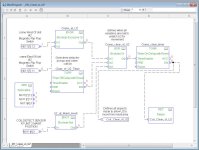Nixalicious
Member
So I am just starting on this whole PLC programming thing and I am a bit confused on the requirements for a function block subroutine work vs a ladder logic subroutine. I like function block a lot better so I do want to stick with it.
I guess my biggest question is do I have to put in a subroutine in my function or can I just use the tags and use the output bit from the routine in my other routines. Like I said I am just learning so if this doesn't make sense please let me know.
Doug
PS I did attach my routine so hopefully it helps.

I guess my biggest question is do I have to put in a subroutine in my function or can I just use the tags and use the output bit from the routine in my other routines. Like I said I am just learning so if this doesn't make sense please let me know.
Doug
PS I did attach my routine so hopefully it helps.




